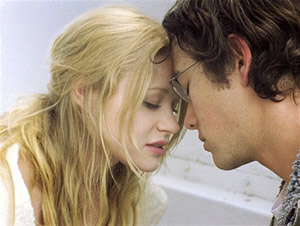|
The image of the lone hero has existed in the English language since before Beowulf. Virtually every popular genre of literature or film is unthinkable without it: the knight errant is the father of the Western sheriff, the private eye, the secret agent, the superhero. The continually retold story of the just man (and, more recently, woman), misunderstood and reviled, beset by dangers on all sides yet possessed of a moral clarity and physical courage that all others lack, fulfills one of the basic needs of humankind. Who among us has not felt misunderstood and reviled? And who among us doesn't find vicarious solace in the quest of the lone knight?
Two films in current release demonstrate the durability and versatility of the legend—one in adulterated form, the other with absolute purity. Mission: Impossible III, by far the more publicized of the two, ironically is a perversion of its own myth. The original TV series celebrated teamwork in its most intricate, urgent form. Peter Graves may have been the leader, but if Martin Landau, Barbara Bain and Greg Morris weren't there with their elaborate technological tricks up their sleeves, he was dead. The three M:I films indeed feature Impossible Mission Force teams, yet the team leader, Ethan Hunt, dispenses with their services more often than not. Indeed, the storylines terminate most of the team members with extreme prejudice. This is because Ethan Hunt is played by Tom Cruise, the ultimate self-mythologizing, lone-wolf action hero of our day.
The first two M:I movies were disappointments, as entertainment if not financially. The first, directed by Brian De Palma, was a series of stuntwork set pieces; the second, directed by John Woo, sacrificed plot and characters to adrenaline rush; and in both, Cruise was the whole damn show. (De Palma's version was especially assiduous in destroying the previously existing M:I universe to assert Cruise's claim to it; it even turned Jim Phelps, the heroic character played by Peter Graves in the series, into a traitor-villain played by Jon Voight.) Only one other member of the IMF team—tech wizard Luther Stickell, played by Ving Rhames—has survived through all three films, and he is Cruise's wisecracking sidekick, by no means a threat to Cruise's dominance.
 M:I III is the best of the franchise—largely, I think, because the director-screenwriter this time around is J.J. Abrams, the mogul behind the hit TV series Lost and Alias. As those programs demonstrate, Abrams understands teamwork, in terms of both plot and practical filmmaking. In M:I III, consequently, Cruise is less the whole show than the first among equals. Abrams actually gives Ethan Hunt a fiancée, Julia, played by Michelle Monaghan, and though there's the requisite stretch where Ethan has to go it alone to prove his honor, this time there are others besides Luther backing him up. Those others may not exactly be fully-fleshed, but Abrams makes us care just enough about them that we have the requisite emotions when all the shootings, explosions, car chases and helicopter crashes start. In essence, Abrams is the first of the M:I directors to give us what we wanted in the first place: a big-budget, extended episode of the TV show. M:I III is the best of the franchise—largely, I think, because the director-screenwriter this time around is J.J. Abrams, the mogul behind the hit TV series Lost and Alias. As those programs demonstrate, Abrams understands teamwork, in terms of both plot and practical filmmaking. In M:I III, consequently, Cruise is less the whole show than the first among equals. Abrams actually gives Ethan Hunt a fiancée, Julia, played by Michelle Monaghan, and though there's the requisite stretch where Ethan has to go it alone to prove his honor, this time there are others besides Luther backing him up. Those others may not exactly be fully-fleshed, but Abrams makes us care just enough about them that we have the requisite emotions when all the shootings, explosions, car chases and helicopter crashes start. In essence, Abrams is the first of the M:I directors to give us what we wanted in the first place: a big-budget, extended episode of the TV show.
Of course, the myth of Ethan Hunt, Lone Hero is inextricable from that of Tom Cruise, Lone Hero. Whatever you think of Cruise's efforts to act that role in his personal life, there's no question he lives it to perfection in the movies. In M: I III he gives us a pristine star turn, full of charisma, swagger and grace. No star alive today does it better, and it was kind of Cruise to abandon his more serious thespian pretensions to those who do that better, such as Philip Seymour Hoffman, Laurence Fishburne, Billy Crudup and Jonathan Rhys Meyers. They, in turn, can take the money from M:I III to finance their next Capote, Othello, Stage Beauty, or Match Point.
Speaking of financing, it took Rian Johnson nine years to raise the $500,000—a sum that wouldn't have paid for Tom Cruise's hair stylist—to make Brick, a '40s-style film noir set in a modern-day Southern California high school. Ha-ha, you think. Bugsy Malone redux. Think again.
 |
A quote from Johnson, published on the Internet Movie Database, speaks very much to his purposes in making Brick: "Teen movies often have an unspoken underlying premise in which high school is seen as less serious than the adult world. But when your head is immersed in that microcosm, it's the most serious time of your life." Some of us have been out of high school longer than we care to admit, yet it doesn't take much imagination to know what Johnson means. We all had to brave bullies, social ostracism, braggart BMOCs, first loves who stopped loving us for no discernible reason. Add drugs and the specter of Columbine to the mix, and suddenly seeing those locker-lined hallways as Raymond Chandler-style mean streets doesn't seem like such a stretch. It's easy for anybody—especially teenagers--to feel utterly alone in such an environment.
In Brick, Johnson gives us Brendan Frye, the ultimate high-school loner. A skinny kid with wire-rimmed glasses and an unruly mop of hair, Brendan looks like he should be holed up in a corner of the school library with a volume of Wallace Stevens. But inside Brendan's soul is the flinty stuff that Sam Spade and Philip Marlowe were made of.
In a high school where the question, "Who do you eat lunch with?" is all-important, Brendan has been eating his lunch alone ever since Emily, the delicate blonde love of his life, dumped him to run with the school's "upper crust." Then one day Emily calls him, obviously in a panic, babbling something about a "brick." They meet, he pours out his love for her, she runs away sobbing.
The next thing Brendan knows, he's staring at Emily's corpse, lying face down in a culvert. From that moment, bringing her killers to justice becomes his obsessive, lonely quest.
You will note that I have spent a few paragraphs describing the story line of Brick—something I did not do with M:I III. This should tell the reader something about the relative quality of the two screenplays, and of their heroes. M:I III is an efficient time-killer, skillfully providing a hoard of Fall Down Go Boom moments for action fans, and Ethan Hunt is an effective, if prefabricated, champion of truth, justice, etc. Brick, despite its extensive borrowings from old detective fiction and movie thrillers, feels absolutely new and fresh, and Brendan Frye, despite his stylized adventures and speech patterns, has a deep humanity that Ethan Hunt cannot begin to approach.
A good part of Brendan's humanity comes from the performance of Joseph Gordon-Levitt, a former child actor who cut his teeth on Disney films (Angels in the Outfield) and sitcoms (Third Rock from the Sun). I had never paid much attention to Gordon-Levitt until, a few months ago, I watched the DVD of Gregg Araki's Mysterious Skin. In that film, Gordon-Levitt plays Neil McCormick, a cold-hearted male prostitute bearing the suppurating mental wounds of childhood sexual abuse. Neil is a remarkable creation, and Brendan Frye is fully his equal. Unless you knew the actor's identity going in, you wouldn't necessarily recognize Brendan Frye and Neil McCormick as the same actor (or either character as Joseph Gordon-Levitt, judging from the photos I've seen of the actor in repose). Quietly, Gordon-Levitt gives us the fire behind those bespectacled eyes and the steel backbone inside that frail-looking body, depicting a questing soul that will breach the walls of Hell for the sake of justice. He can give beatings (he gives a couple, always deserved, in the course of the movie) or take them (he takes very, very many), and he seeks no one's help except that of his only friend, the Brain, played with nerdy aplomb by Matt O'Leary. Yet Brendan also is touchingly vulnerable, bearing—as did Neil in Mysterious Skin—the wounded innocence of a boy-man forced to grow up much too fast. Few actors have ever played that innocence as well as Gordon-Levitt, and though at 25 he's reaching the end of the time that he can play that particular card, something tells me he has a lot more cards in his deck.
Brick is remarkably stylish for its small budget, thanks to Johnson's own editing, Steve Yedlin's insinuating camera work and Jodie Tillen's atmospheric production design. Brendan and his classmates are trapped in their claustrophobic little world of concrete halls and run-down tract houses as surely as Rilke's panther, seeing no world outside the cage bars. Every detail of the film's design is carefully chosen, down to the shoes. The first image we see in Brick is a close-up of Brendan's shoes—scuffed, worn-out brown oxfords, the sort of shoes that would immediately get him branded a dweeb in high-school circles, but which bespeak a rocklike honesty and a coolness beyond what passes in school for cool. (Brendan takes off his shoes exactly once during the movie, setting up one of its funniest sight gags.)
Many of the reviews for Brick have been tepid, or worse. Critics complain about its convoluted plot, its impenetrable dialogue (Johnson creates an argot halfway between private-eye slang and teen speak), its artificial characters. But convoluted plots have always been a hallmark of the film noir; I found Brick, for all its twists and turns, a lot easier to understand than, say, The Big Sleep. (There was, however, a plot detail toward the end involving Brendan's jacket that I thought would have major repercussions, but never did.)
 |
I grant that the dialogue presents difficulties at first, particularly since Johnson directs his actors to speak very quickly and allows them to mumble (Marlon Brando and James Dean aren't always good examples for young actors). But I got the hang of it as the film progressed, and—if you look at the glossary on the film's Web site—the slang terms Johnson uses aren't all that esoteric (i.e. "burg" for "town," "blow" for "leave," "clam" for "shut up"). At its best, Johnson's dialogue has an epigrammatic poetry reminiscent of vintage Chandler and Hammett, such as Brendan talking to the school's overbearing assistant vice principal (played by Richard Roundtree) about a drug dealer he'd previously turned over to him: "I gave you Jared to see him eaten, not to see you fed." I also loved the pithy exchange between Brendan and the hotheaded goon Tugger, played by Noah Fleiss:
BRENDAN: Got a cigarette?
TUGGER: I don't smoke.
BRENDAN: I've seen you smoke.
TUGGER: I don't smoke cigarettes.
As for the characters, again I don't see how any movie character could be much more compelling or sympathetic than Brendan Frye. The critics may be thinking of Brick's two femmes fatales, Laura and Kara, since femmes fatales aren't supposed to be sympathetic (and no disrespect intended to Nora Zehetner and Meagan Good, the fine young actresses who play them). But Fleiss certainly finds an unexpected rational streak in the murderous Tugger, and O'Leary, as the Brain, convincingly plays a brilliant boy just waiting to achieve an age when people will respect him for what he is. I also admired the performances of Lukas Haas as the Pin, a cadaverous criminal mastermind who runs his drug empire from his mother's plywood-paneled basement; of Emilie de Ravin as Emily, a sad girl blinded by the allure of what she thinks she wants; and of Noah Segan as the pathetic stoner Dode, who also loves Emily and pays dearly for misconstruing the mystery of her disappearance.
In Brick, Rian Johnson uncovers a little-acknowledged truth about young American lives, and transforms it into a film of uncommon wit, intelligence, and excitement. I just wish more people would see it. (Last weekend, Hollywood pundits were decrying the lackluster box-office opening of M:I III, at "only" $47.7 million; meanwhile, according to the Rotten Tomatoes Web site, Brick earned $1.27 million in four weeks of release.) Brick is a movie you'll probably have to see twice to catch all its intricacies of dialogue and plot, but—this is the point—you will want to see it twice. Brick is the first new movie since Sideways that, after seeing it, I wanted to rush out immediately and buy the DVD. That's the difference between Brendan Frye, classic hero, and Ethan Hunt, prefab hero, just as it's the difference between Joseph Gordon-Levitt, actor, and Tom Cruise, star. 
|